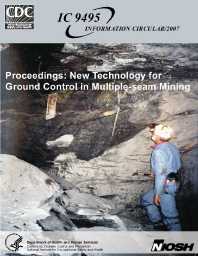Mining Publication: Proceedings: New Technology for Ground Control in Multiple-seam Mining
Original creation date: May 2007
Multiple-seam interactions are a major ground control hazard in many U.S. underground coal mines. In some U.S. coalfields, particularly in central Appalachia and the West, the majority of today's mines are operating above and/or beneath previously mined seams. The effects of multiple-seam interactions can include roof falls, rib spalling, and floor heave. These can seriously disrupt mining operations and threaten the safety of miners. In early 2006, a West Virginia coal miner was killed by rib roll that occurred in a high-stress zone beneath a remnant structure in an overlying mine. Fortunately, not every multiple-seam situation results in hazardous conditions. Indeed, the vast majority do not. For the past several years, the National Institute for Occupational Safety and Health has been conducting research to develop better techniques for predicting the location and severity of multiple-seam interactions. During this investigation, more than 50 mines were visited across the U.S. coalfields. Nearly 300 case histories were collected and analyzed using multivariate statistical techniques. The study also employed the numerical model LaM2D to estimate the multiple-seam stress, the Analysis of Longwall Pillar Stability (ALPS) and the Analysis of Retreat Mining Pillar Stability (ARMPS) programs to determine pillar stability factors (SFs), and the Coal Mine Roof Rating to measure roof quality. The study focused on the two most common types of multiple-seam interactions: 1. Undermining, where stress concentrations caused by previous full extraction in an overlying seam is the main concern; and. 2. Overmining, where previous full extraction in an underlying seam can result in stress concentrations and rock damage from subsidence. The study confirmed that overmining is much more difficult than undermining, and isolated remnant pillars cause more problems than gob-solid boundaries. For the first time, however, it was possible to quantify these effects in terms of the equivalent thickness of interburden needed to compensate for them. The study also found that pillar design is a critical component of multiple-seam mine planning. Many of the failed cases involved pillars whose SF seemed inadequate once the multiple-seam stresses were accounted for. Weaker roof was also found to significantly increase the risk of multiple-seam interactions. The most important result of the study is an equation that predicts the critical thickness of the interburden required to minimize the likelihood of a multiple-seam interaction. This equation was incorporated into a step-by-step methodology that allows mine planners to evaluate each potential interaction and take steps to reduce the risk of ground control failure. Such measures could include installing cable bolts or other supplemental support, increasing the pillar size, or changing the mine layout to avoid the remnant structure entirely. These Proceedings also contain several previously published papers that cover other facets of multiple-seam mining research. Two papers describe the LaModel family of software developed by Professor Keith A. Heasley of West Virginia University. The LaModel programs were designed for calculating the stresses and displacements in coal mines or other thin, tabular seams in layered media. The original three-dimensional version of LaModel is essential for detailed analyses of complex multiple-seam scenarios. LaM2D, by contrast, implements a simplified two-dimensional model that is suitable for quick approximations of the multiple-seam stresses and strains. Three additional papers in these Proceedings describe the extensive multiple-seam experience of the Harris Mine, examples of extreme multiple-seam mining from the central Appalachian coalfields, and longwall mine experiences in Pennsylvania, West Virginia, and Utah. The final paper reports on a numerical modeling study that provided some insight into the mechanics of multiple-seam mining.
Authors: C Mark, RJ Tuchman
Information Circular - May 2007
NIOSHTIC2 Number: 20032022
Pittsburgh, PA; U.S. Department of Health and Human Services, Public Health Service, Centers for Disease Control and Prevention, National Institute for Occupational Safety and Health, DHHS (NIOSH) Publication No. 2007-110, IC 9495, 2007 May; :1-88
See Also
- Advance and Relieve Mining: A Method to Mitigate the Effects of High Horizontal Stress on the Mine Roof
- Coal Bumps and Odd Dynamic Phenomena - A Numerical Investigation
- Current Trends in Reducing Ground Fall Accidents in US Coal Mines
- Determination of In Situ Deformation Modulus for Cemented Rockfill
- Dynamic Failure in Deep Coal: Recent Trends and a Path Forward
- Effects of Weak Bands on Pillar Stability in Stone Mines: Field Observations and Numerical Model Assessment
- A Hydrodynamics-Based Approach for Predicting the Blast Damage Zone in Drifting as Demonstrated Using Concrete Block Data
- Investigation of Pillar-Roof Contact Failure in Northern Appalachian Stone Mine Workings
- Methane Diffusion Parameters for Sized Coal Particles: A Measuring Apparatus and Some Preliminary Results
- Numerical Model Calibration for Simulating Coal Pillars, Gob and Overburden Response
- Content source: National Institute for Occupational Safety and Health, Mining Program


 ShareCompartir
ShareCompartir
